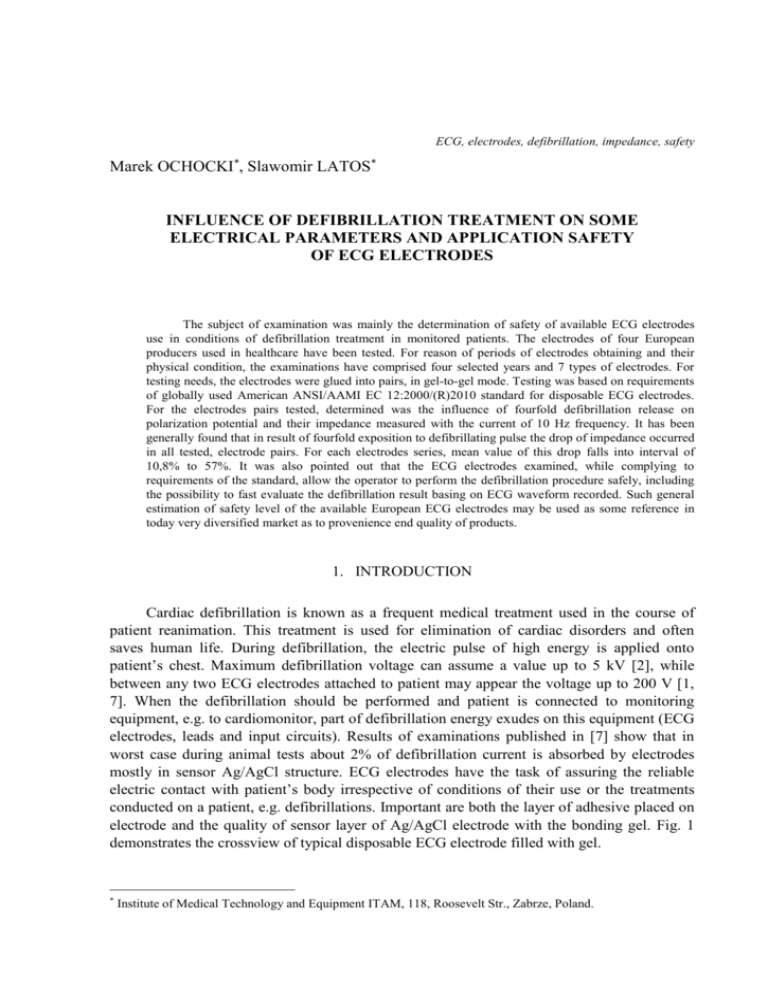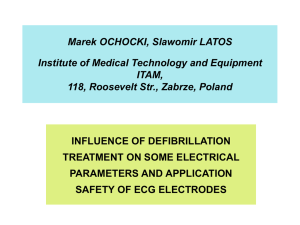Tomasz Rembisz
advertisement

ECG, electrodes, defibrillation, impedance, safety Marek OCHOCKI*, Slawomir LATOS* INFLUENCE OF DEFIBRILLATION TREATMENT ON SOME ELECTRICAL PARAMETERS AND APPLICATION SAFETY OF ECG ELECTRODES The subject of examination was mainly the determination of safety of available ECG electrodes use in conditions of defibrillation treatment in monitored patients. The electrodes of four European producers used in healthcare have been tested. For reason of periods of electrodes obtaining and their physical condition, the examinations have comprised four selected years and 7 types of electrodes. For testing needs, the electrodes were glued into pairs, in gel-to-gel mode. Testing was based on requirements of globally used American ANSI/AAMI EC 12:2000/(R)2010 standard for disposable ECG electrodes. For the electrodes pairs tested, determined was the influence of fourfold defibrillation release on polarization potential and their impedance measured with the current of 10 Hz frequency. It has been generally found that in result of fourfold exposition to defibrillating pulse the drop of impedance occurred in all tested, electrode pairs. For each electrodes series, mean value of this drop falls into interval of 10,8% to 57%. It was also pointed out that the ECG electrodes examined, while complying to requirements of the standard, allow the operator to perform the defibrillation procedure safely, including the possibility to fast evaluate the defibrillation result basing on ECG waveform recorded. Such general estimation of safety level of the available European ECG electrodes may be used as some reference in today very diversified market as to provenience end quality of products. 1. INTRODUCTION Cardiac defibrillation is known as a frequent medical treatment used in the course of patient reanimation. This treatment is used for elimination of cardiac disorders and often saves human life. During defibrillation, the electric pulse of high energy is applied onto patient’s chest. Maximum defibrillation voltage can assume a value up to 5 kV [2], while between any two ECG electrodes attached to patient may appear the voltage up to 200 V [1, 7]. When the defibrillation should be performed and patient is connected to monitoring equipment, e.g. to cardiomonitor, part of defibrillation energy exudes on this equipment (ECG electrodes, leads and input circuits). Results of examinations published in [7] show that in worst case during animal tests about 2% of defibrillation current is absorbed by electrodes mostly in sensor Ag/AgCl structure. ECG electrodes have the task of assuring the reliable electric contact with patient’s body irrespective of conditions of their use or the treatments conducted on a patient, e.g. defibrillations. Important are both the layer of adhesive placed on electrode and the quality of sensor layer of Ag/AgCl electrode with the bonding gel. Fig. 1 demonstrates the crossview of typical disposable ECG electrode filled with gel. * Institute of Medical Technology and Equipment ITAM, 118, Roosevelt Str., Zabrze, Poland. Fig.1 ECG electrode Fig. 2 below presents the electric model of electrode-gel-patient’s skin structure [3]. ECG electrode may be treated like parallel connection of capacity and resistance [3]. In case of defibrillation pulse presence, part of energy exudes on internal resistance and electrode polarization takes place. Fig.2 Schematic representation of the skin and its equivalent circuit model according to [3]. The energy exuding on electrode impedance may result in degradation of Ag/AgCl sensor layer and thereby impairment of electrode characteristics [3]. Long-term electrode exposition to current, especially of large intensity, causes the damage of ECG sensor structure [3]. Whereas, currents of low intensity may cause increase of polarization potential of electrode. According to publication [6], the through current of 100 nA produces increase of polarization voltage by 0,5 mV within 25 min. The layer of silver and silver chloride Ag/AgCl of ECG electrode, constituting the part of ECG measurement channel, should not receive worsening of properties due to defibrillation of patient’s heart. Such defibrillation admittedly is a procedure not so often used, nevertheless ECG electrodes shall comply with requirements according to [1]. Test results published in [4] indicate that impedance measurement of gel-to-gel glued electrode pairs corresponds to such measurement on abraded patient’s skin. According to standard [1], the measurement of ECG electrodes impedance is performed with a sine wave current of 10 Hz frequency. 2. DESCRIPTION OF EXAMINATION PROCEDURE 2.1. PREPARATION OF ECG ELECTRODES The tests were conducted on disposable ECG electrodes filled with gel. The electrodes were commercially available on the market. They were obtained from four European manufacturers, including Polish one. In first years, only one electrode type from each manufacturer was at disposal. In last 2012 year, there was a possibility to tests four various electrode types obtained from one manufacturer. All the electrodes were new and unused. Packages of electrodes used to testing were not broken. Such principles were helpful in assuring the test conditions corresponding to intended use of all electrodes being disposable devices. For testing purposes, the electrodes had removed their foil shields and were glued into pairs using their own adhesive layer, in gel-to-gel mode. 2.2. MEASURING INSTRUMENTS For tests conduction, the set of instruments was used consisting of the defibrillation tester, multimeter and computer (Fig. 3). All testing devices had valid metrological certificates. The measurements have been done in ambient temperature +23C ±2ºC and humidity 45% ±10%. Fig.3 System for defibrillation testing of ECG electrodes according to [1] 2.3. MEASUREMENT OF ELECTRIC PARAMETERS OF ECG ELECTRODES Measurement procedure was based on requirements of standard [1]. Except for one testing lot, in all remaining lots the number of electrode pairs being accessible was 12 as minimally requires the standard. Only in one case, at the disposal were 7 pairs, which also is of testing value, especially in such overall analysis. After gluing consecutive two electrodes into pair in gel-to-gel mode, the tests were performed one after the other as follows: − polarization potential of electrodes after 60÷90 s from the moment of electrodes gluing into pair, − impedance with the 10 Hz current, − fourfold defibrillation − according to schematic diagram in Fig. 4., − impedance with the 10 Hz current after defibrillation. Fig.4 Electric scheme for defibrillation testing of ECG electrodes according to [1] In circuit of Fig. 4, for a period of 10 s, the switch SW1 is short-circuited in order to charge the capacitor 10 µF up to the voltage 200 V. Thereafter the SW1 is opened and SW2 closed for 2 seconds, thus simulating impact of defibrillation pulse on electrode pair by the discharge of electric charge stored in the capacitor. Then SW2 is opened and SW3 closed thereby connecting the electrode pair under test to measurement system having input impedance 10 MΩ. measuring amplifier sinusoidal current source of efficiency 80µA/10Hz tested electrode pair elektrod Ka=12,5V/V oscilloscope Fig. 5 Measurement circuit for testing the electrodes impedance with 10 Hz current In circuit according to Fig. 5 for impedance measurement of electrodes, the output signal from amplifier is measured on any oscilloscope. Peak-to-peak signal amplitude equal to 1V corresponds to 1 kΩ impedance of the electrode pair tested. Measuring range is 0 to 7 kΩ and is limited from the top by the supply voltages of amplifier. 3. RESULTS 3.1. CHANGES OF ELECTRODES IMPEDANCE In the Table 1. below, compiled are the results of impedance measurements of examined electrode pairs prior to and after the defibrillation pulse. The tests have been done suitably for disposal of not impaired electrodes in four selected years. In each year 2006, 2007 and 2011, there was one electrode type of consecutive manufacturer available. In 2012, one manufacturer has delivered four various types of its electrodes. The markings (A, B, C, D) of electrode types of this manufacturer are symbolic here. Table 1. Results of impedance measurements for electrode pairs examined, in four selected years Measured impedance parameters Years of examinations conducted 2006 2007 2011 2012 Electrode types of one producer and Each year quantity of electrode pairs tested one electrode type from one producer, A B C D and quantity of 7 pairs 12 pairs 12 pairs 12 pairs 12 electrode pairs tested Impedance interval before 0,29÷0,38 0,41÷0,48 0,04÷0,06 0,21÷0,41 0,23÷0,46 0,18÷0,29 0,16÷0,34 defibrillation k Mean impedance value 0,34 0,44 0,05 0,27 0,34 0,22 0,22 before defibrillation k Impedance interval after 0,28÷0,32 0,30÷0,37 0,03÷0,04 0,17÷0,37 0,08÷0,22 0,07÷0,13 0,12÷0,16 defibrillation k Mean impedance value after 0,30 0,34 0,04 0,23 0,15 0,10 0,15 defibrillation k Interval of impedance 0,0÷23,7 9,9÷31,4 17,2÷29,5 2,2÷21,9 46,9÷71,7 51,1÷69,6 12,1÷55,4 drop % Mean value of 10,8 21,8 22,3 13,8 56,3 57,0 31,2 impedance drop % After each defibrillation exposition that impacted consecutive electrode pair, the polarization voltage appearing on such electrodes assembly has been measured in circuit of Fig. 4. Before the measurement, terminals of electrode pairs were connected to DC voltmeter with significant input resistance. The example of selected typical plot of electrodes polarization potential in time during a series of four defibrillation expositions is presented in Fig. 6. EKS 56 P (LOT 2011-02-10) 30 Polarization potential [mV] 25 20 15 10 5 0 00:00 00:15 00:30 00:45 01:00 01:15 01:30 01:45 02:00 02:15 02:30 02:45 03:00 03:15 03:30 Time [min:s] Fig.6 Example of polarization potential in time during a series of defibrillation expositions impacting the electrode pair chosen All the remaining electrode pairs have been checked in this way. 4. DISCUSSION The workmanship quality of ECG electrodes has considerable meaning from the viewpoint of so-called traditional in standards ‘basic safety’ and particularly ‘essential performance’ related to evident functional safety of medical device. These two kinds of safety in last years have become apparently differentiated by the way of publishing the 3-rd Edition of general standard for electromedical equipment. These safety terms are already seen in the title of this standard and its further supplementing parts. General standard in question firstly was the IEC 60601-1 edition of 2005, then European [2] and Polish 2006 version in English language inside. In Polish language version this standard has been published in 2011. The official implementation into use as so-called harmonized standard in Europe has just started in June 2012. Hence, among other things, the topicality of such new official functional safety area. It’s worth mentioning that closely related collateral and particular standards of 606011… standards family have the same two safety areas, which are seen in their titles and internal structure. Before, this kind of safety was scattered mainly in hands of equipment designers and users, in some cases − the subject of particular or branch standards or technical specifications. ECG electrodes should assure good and reliable electrical contact of input circuit of electrocardiographic equipment with the patient’s body. Meaningful are both glue quality (gel parameters) and the quality of Ag/AgCl sensing layer. Increase of ECG electrodes impedance may cause unwanted decrease of common mode rejection ratio (CMRR) of ECG amplifier channel. This raises disturbing interference of alternative current on ECG waveform [5]. The rise of ECG electrodes impedance could result also in augmentation of exuded energy during defibrillation or even electrosurgical operation. This could involve heating up of electrodes and the patient's burns [3]. It has been found that in result of fourfold defibrillatory exposition the impedance drop in all examined electrode pairs has occurred. Mean value of this drop for each electrode lot falls into 10,8% do 57% interval. The ECG electrodes checked in these examinations certainly meet the requirements of aforementioned American standard [1], to not exceed 2 kΩ by the mean impedance value from measurement of each production lot of 12 electrode pairs, and individually be below 3 kΩ. The data in the Table 1 indicate the considerable margin of safety in this respect. The standard even permits some increase of electrodes impedance. Meanwhile, the measurements show that in tested electrodes the positive effect of impedance decrease took place. After each defibrillation, the offset voltage between glued electrodes was also monitored. It has been found that polarization voltage quickly decreases. In all the measurements, the electrode pairs have met the requirement of standard [1] to not exceed value 100 mV by measured offset voltage after 1-minute stabilizing period. It was met with considerable margin. Due to some regulations and codes of practice, the names of manufacturers could not be disclosed here. What’s the more, the unknown production processes of these electrodes and restricted amount of testing material, made impracticable the detailed quantitative assessments of electrodes quality. This could be the subject of separate, advanced and expensive studies. Although research work is valuable and recommended in standardization world, in many cases, the basic approach is the guidelines establishing basing on collaborative opinion of experts teams. This paper, hopefully, could be especially useful for them. So in these examinations and in this paper, the more general estimations have been possible and essential. In standards use, the compliance statements have the basic meaning. There is still considerable area in medical and hospital technology, where such knowledge is alarmingly missing. 5. CONCLUSIONS The results of conducted examinations have put in a good light the quality of ECG electrodes of four selected European manufacturers, including Polish one, which makes possible safe use of the electrodes on patients undergone such serious treatment as cardiac defibrillation. Electrodes ensure good electrical parameters also after defibrillation discharge allowing the physician to obtain quickly information necessary for assessment of the effectiveness of this medical reanimation procedure. These examinations may have referential meaning and can be used in wider analyses of safety condition of health care procedures. It is worth to be noted that on today market more and more medical devices appears from outside Europe. Their quality is not stable. In this connexion, it may be advisable to make periodic or special checking of accessible sample lots of such products, especially when considerable long and little controlled are transport and storage periods. In rough conditions, possible may be damages or parameters impairing, particularly in semi-liquid materials like the gels. There may also be impermissible swaps of ingredients or components in final products, that are not so rare situations. In such cases, as we are already convinced, the test results can be considerably worse. Regarding widely used disposable ECG electrodes, the more substantiated recommendation is justified for checking compliance to mentioned global American standard declared by the new dynamic producers. One recently met interesting example in the imported device, where let’s say ‘new approach’ to electrical safety of medical equipment relied on serious confusing of some terms of quite different ‘classes of protection’ (I, II, with internal energy source) with ‘protection types’ (CF, BF, B) of electromedical equipment. The electrically general classes of protection concern mainly the mains part of devices, whereas protection types concern the applied parts contacting the patients. This is not a sole example of risk encountered in medical equipment area. What’s the more, the electrodes for contact with patients are very sensitive elements of patient-to-equipment interface. Hence, the example of ECG electrodes is valuable because very common medical technology area is here involved. The knowledge of biomedical technology standards is immensely complex, however is growingly crucial for ambitious an legally proper design process of electromedical equipment, including the accessories and hospital procedures. BIBLIOGRAPHY [1] [2] [3] [4] [5] [6] [7] ANSI/AAMI EC 12:2000/(R)2010 Disposable ECG electrodes. EN 60601-1:2006 Medical electrical equipment. Part 1: General requirements for basic safety and essential performance. HOI-JUN YOO, VAN HOOF CH. Bio-Medical CMOS ICs (Integrated Circuits and Systems) 2011, pp 31-124, Springer, New York KLINGLER DR, SCHOENBERG AA, WORTH NP, EGLESTON CF, BURKART JA. A comparison of gel-to-gel and skin measurements of electrode impedance. Med. Instrum. 1979 Sep-Oct;13(5):266-8. OLSON WH, SCHMINCKE DR, HENLEY BL. Time and frequency dependence of disposable ECG electrode-skin impedance. Med. Instrum. 1979 Sep-Oct;13(5):269-72. PATTERSON RP. The electrical characteristics of some commercial ECG electrodes. J Electrocardiol. 1978 Jan;11(1):23-6 SCHOENBERG AA, BOOTH HE, LYON PC. Development of standard test methods for evaluating defibrillation recovery characteristics of disposable ECG electrodes. Med. Instrum. 1979 SepOct;13(5):259-65







